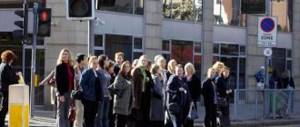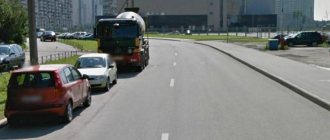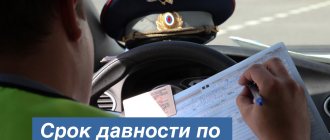Imperfection of the Rules
The current traffic rules were inherited by Belarus from the USSR, and many of them are outdated, and many are not provided for.
For example, the Rules do not mention such types of transport as electric bicycles and electric scooters, although they are capable of developing decent speeds and there are more and more of them on city streets every year. People on roller skates, skateboards, hoverboards, Segways, and unicycles are considered pedestrians, and according to the Rules they must ride on pedestrian paths, not bicycle paths.
You can also see signs on the streets that are not in the Rules. For example, a “pedestrian crossing” sign with a silhouette of a cyclist added to a human figure:
The legal force of such a road sign today is the same as that of street graffiti, that is, none.
In Minsk you can find “bicycle crossings”, which are supplemented with green markings with a picture of a bicycle - such markings are also not in the traffic rules.
Conventional hand signals
Before any maneuver, the driver of the car must signal with the direction indicators. Bicycles usually do not have turn signals, so a system of hand signs is used:
Stop - hand raised up (it doesn’t matter whether it’s right or left). Turn to the left - a straight left arm extended to the left side (towards the turn) or a right arm bent at the elbow and raised up. Turn to the right - a straight right arm extended to the right side (in the direction of the turn) or a left arm bent at the elbow and raised up.
It is best to show these signals in advance so that everyone has time to notice and understand them.
Who is he really?
A set of traffic rules will help solve the problem of self-determination for a cyclist. Following the definition formulated by the rules of the road, a bicycle is a non-motorized vehicle, and a cyclist is its driver. A dismounted cyclist peacefully transporting his vehicle across the roadway automatically turns into a pedestrian (clause 1.2). The conclusion is simple: the crossing is pedestrian, which means that only pedestrians, that is, cyclists driving a bicycle, have the right to cross it.
Note. There is only one difference in the behavior of pedestrians and those who become pedestrians when starting from a bicycle: outside populated areas, people move along the roadway towards the traffic flow, and dismounted cyclists move in the same direction as the traffic flow (section 4.1)
The importance of following the rules of cycling
According to the law, in accordance with the traffic rules, a bicycle is a vehicle, and a cyclist is a driver. Therefore, all the rules that apply to vehicles also apply to bicycles. This is the first important point.
All the same rules indicate that a pedestrian is a person who is outside of transport on the road or pedestrian crossing.
Pedestrians also include persons who move:
- with baby strollers, sleds;
- on roller skates, scooters;
- independently in wheelchairs, or being driven by them;
- walking along the zebra crossing and driving a bicycle next to them.
This is the second important point.
The driver will not be a pedestrian when he rides a bicycle on the road, but if he drives a bicycle next to him by the steering wheel, he becomes one. In certain circumstances, according to the rules, the driver can get off the bike and move like a pedestrian.
The driver of a vehicle must comply with all traffic rules in order to avoid accidents on the roadway, this also applies to cyclists. If traffic rules are not followed, the bicycle driver not only puts himself at risk, but also creates dangerous situations on the roads where pedestrians and cars with drivers can be harmed. Deaths cannot be ruled out.
On the Internet you can see a large amount of video material where the most flagrant violations of the rules by riders are recorded. One of them is riding a bicycle across a pedestrian crossing, which usually ends very badly. According to the law, according to traffic rules, only pedestrians can move along the pedestrian crossing.
How to properly cross the road for a pedestrian according to traffic rules - are there fines for violations?
But on roads with heavy traffic, such a stop is unsafe both for the pedestrian and for drivers. Therefore, it is necessary to calculate the time before setting foot on the roadway.
When the transition is carried out by an organized group of people, two accompanying persons mark the beginning and end of the column.
For these purposes, they are given red flags. You need to cross the road in specially equipped places. The safest pedestrian crossings are those located above or below the roadway. Also, regulated and unregulated pedestrian crossings will be installed to cross the road. If they are not there, the road is crossed in the area of the nearest intersection or in an open place with a good view on both sides of the traffic.
At intersections, traffic is regulated by traffic lights or, less commonly, by traffic controllers. In this case, an intersection is considered controlled if the traffic lights change (red-yellow-green).
Provided liability for violating the rules
Failure to comply with traffic rules results in penalties. Violators, in accordance with Article 12.29 of the Rules, bear the following liability:
| Did not find an answer to your question? Call a lawyer! Moscow: +7 (499) 110-89-42 St. Petersburg: +7 (812) 385-56-34 Russia: +7 (499) 755-96-84 |
- a fine of 200 rubles when crossing a zebra crossing without dismounting a bicycle. In case of a primary violation, a warning may be issued, but only at the discretion of the traffic police inspector. The violation is classified as obstructing pedestrians and other vehicles;
- If a drunk bicycle driver is also added to the above violation, then the fine increases to 300-500 rubles.
Compliance with traffic rules will save the cyclist from a fine and the risk of getting into an accident.
What cyclists should not do
According to the traffic rules of Belarus, cyclists are not allowed to:
Use faulty bicycles (handlebars, brakes), and in the dark - bicycles without working lights. Children under 14 years of age may not drive on the roadway unless accompanied by an adult. Drive on the motorway. Drive drunk or under the influence of drugs. Drive under the influence of drugs that reduce attention and reaction speed, in a sick or tired state, if this may threaten road safety. Use your phone while driving if you can’t do it hands-free. Drive in snow or icy conditions. Ride without holding the steering wheel or keeping your feet on the pedals. Turn left or make a U-turn on a road with tram tracks or two or more lanes. Transport passengers. Children under 7 years old can ride on an additional specially equipped seat. Carry loads that interfere with the handling of the bicycle or stick out more than half a meter to the sides, forward or backward. Tow a bicycle or a bicycle
The exception is industrial bicycle trailers.
About the cyclist and street traffic
Traffic rules of the Russian Federation
1. General Provisions. “Bicycle” is a vehicle, other than a wheelchair, which has at least two wheels and is driven, as a rule, by the muscular energy of the occupants of the vehicle, in particular by means of pedals or handles, and may also have an electric motor with a rated maximum power in continuous load mode not exceeding 0.25 kW, automatically switching off at speeds over 25 km/h.
The traffic rules establish that riding a bicycle (including an electric bicycle, two- or three-wheeled scooter, Segway, electric scooter, hoverboard, electric monocycle) for children under the age of 7 years is permitted only on sidewalks, pedestrian and bicycle paths (on side for pedestrian traffic), as well as within pedestrian zones.
Children aged 7 to 14 years old are allowed to ride bicycles only on sidewalks, pedestrian, bicycle and bicycle paths, as well as within pedestrian zones.
Young people over 14 years of age are allowed to ride a bicycle on the right edge of the roadway if:
1. there are no bicycle and bicycle pedestrian paths, a lane for cyclists, or there is no opportunity to move along them;
2. if the overall width of the bicycle, its trailer, or the cargo being transported exceeds 1 m;
3. if the movement of cyclists is carried out in columns;
4. Driving along the side of the road is allowed - if there is no lane for cyclists, bicycle and bicycle pedestrian paths, or it is not possible to move along them or along the right edge of the roadway.
This age category of cyclists (over 14 years old) is allowed to ride on the sidewalk or pedestrian path in the following cases:
1. if there are no bicycle and bicycle pedestrian paths, a lane for cyclists, or there is no opportunity to move along them, as well as along the right edge of the roadway or shoulder;
2. if the cyclist is accompanying a cyclist under the age of 14 years, or transporting a child under the age of 7 years on an additional seat, in a bicycle stroller or in a trailer designed for use with a bicycle.
Cyclist at a pedestrian crossing: cross or run over?
One of the readers addressed the “” section with a question that, as it seems to him, is very relevant: how should cyclists behave at a pedestrian crossing - cross or move? For clarity, a video was also published: So what should a cyclist do at a pedestrian crossing: cross or move?
If you look, you can conclude that there is no clear answer there either: Lawyer: A cyclist on a zebra crossing must follow on foot. “Pedestrian crossing” is a section of the roadway marked with signs 5.19.1, 5.19.2 and (or) markings 1.14.1 and 1.14.2* and allocated for the movement of pedestrians across the road. In the absence of markings, the width of the pedestrian crossing is determined by the distance between signs 5.19.1 and 5.19.2.
“Road” is equipped or adapted and used for the movement of vehicles. This does not mean that only vehicles can drive on it.
pedestrians are also allowed to walk on roads. Elena: “Pedestrian” is a person who is outside the vehicle on the road and does not perform work on it.
Persons moving in wheelchairs without a motor, driving a bicycle, moped, motorcycle, carrying a sled, cart, baby or wheelchair are considered pedestrians. Anatomist: - marat16rus: “Bicycle” is a vehicle, other than wheelchairs, having two or more wheels , and driven by the muscular power of the people on it. So everything is correct, a cyclist riding a bike on the road must obey the same rules as a car driver, since he is a VEHICLE.
And you must cross the zebra crossing on foot, otherwise you are violating the traffic rules - you are actually driving at a prohibiting traffic light, which is currently RED for vehicles. Legal consultant: - In fact, the cyclist violated the traffic rules as such, and not their specific point.
Any driver of a vehicle will violate the traffic rules by starting to move along the subdivision, but not a single specific paragraph of the traffic rules prohibits such an action, and the word “only” in paragraph 24.2 is also not a prohibition. Moreover, you will not find in the traffic rules a ban on the movement of cars along the subdivision. The prohibition is contained in the conclusion about the purpose of the pedestrian crossing.
This, by the way, is not a rare situation in jurisprudence when the prohibition of a certain action is not determined by the words of a specific norm, but is a consequence of a complex conclusion about the meaning of the content of a norm, a number of norms, or the definition of a concept used in legislation. Punishment for driving on a subdivision is provided for a bicycle driver Part 2 of Article 12.29, and for the driver of an automatic telephone exchange - Art.
12.12, 12.15, 12.16 .
Basic rules for cyclists
When riding a bicycle along a city highway, the driver must strictly follow the rules of the road: observe the speed limit, follow the information on the road signs, stop and continue driving when the traffic light signals. For example, if there is a “closed road” sign (brick) on the highway, then the cyclist has no right to proceed further, like any vehicle. A bicycle (according to the rules) clause 14.1 must pass:
- pedestrians at pedestrian crossings where there are no traffic lights;
- on roads where there is traffic of trams, pedestrians getting off the tram, and those heading to board the tram.
According to the law, on city roads, a cyclist over 14 years of age can move (rules clause 24. 1-6):
- on bicycle paths or designated lanes;
- along the right edge of the roadway - if there is no special lane or path and only in one row (if there are several riders at the same time);
- on the side of the road - you can drive only if the options listed above are not possible.
Riding a bicycle on sidewalks is permitted for children under 14 years of age or for adults when transporting a child under seven years of age, in exceptional cases for adults when there is no other way to travel on the highway. But it is important to note that when there is a large flow of people on the sidewalks, then in order to avoid an accidental collision with pedestrians, it is advisable for the cyclist to dismount and drive the bike next to the handlebars. This is stated in the DD rules.
The most frequently violated points from DD rules by cyclists are:
- Technical condition of bicycle transport - a technical inspection is carried out before each exit onto the city roadway (clause 2.3). You cannot ride a faulty bicycle;
- Alcohol intoxication – driving while intoxicated is prohibited (clause 2.7);
- Turn signals are required. If he intends to turn, change lanes, or brake, the cyclist must give a light signal or a hand signal in advance (in the direction he is turning, clause 8.1);
- Turning left, as well as turning around on the roadway (where there is more than one lane in one direction) on a bicycle is prohibited according to the rule (clause 24.8). Exit – the cyclist needs to get off the bike and cross the pedestrian crossing in the right direction, then continue the journey as a driver;
- Riding a bike against the flow of traffic, as well as driving along a pedestrian crossing is prohibited, it is very dangerous! Often it is in such situations that children and teenagers die. Exit - in the first option, move only with the flow of vehicles in one direction, in the second - dismount and cross the zebra crossing like a pedestrian.
According to the law, for violation and failure to comply with traffic rules, cyclists are charged fines of 800 rubles. up to 1000 rubles, when driving a bicycle while drunk or causing harm to health from 1000 rubles. up to 1500 rub.
He has no place among us!
A similar situation of inappropriateness occurs when a cyclist appears in a pedestrian area. In order not to disturb people walking on the sidewalk, cyclists should remember that they should ride in order of priority in the following areas:
- pedestrian paths;
- roadside;
- along the right edge of the roadway.
Driving on the sidewalk is permitted if you are under 14 years of age, you are transporting or accompanying a preschooler, and also if there is no possibility of driving in higher priority zones. In most of our cities there are still no opportunities to fully move along bicycle or bicycle-pedestrian paths, and the roadsides are littered with either garbage or snow. Then it is safer to actually move on the sidewalk.
At the same time, it is important to remember the clarification contained in paragraph 6 of Article 24 of the Traffic Rules, reminding that in the case when cycling interferes with the movement of pedestrians, the cyclist’s duties include a precautionary attitude towards people: the bicycle driver is obliged to get down and continue the journey through the “densely populated” part roads on foot. If a cyclist enters a pedestrian zone, this only means that you need to move along it as slowly and carefully as possible.
Road signs and markings
There are several road signs in the current Regulations that relate to the regulation of cyclists.
A "Bike Path" sign means you can only ride a bicycle
. Sometimes you can walk along a bike path, but only if there is no sidewalk or pedestrian path nearby. At the same time, the pedestrian should not interfere with cyclists.
“Pedestrian path” - only pedestrians
, but if there is no bicycle path nearby, you can ride a bicycle, but without interfering with pedestrians.
The “Intersection with a bicycle path” sign warns drivers or pedestrians that there is a bicycle path ahead and they need to be extremely careful.
If there is a “No Bicycles” sign along the roadway, then you are not allowed to ride there, regardless of whether there are obstacles on the sidewalk or bike path or not.
What the law says
Pedestrians, motorists and drivers of non-motorized vehicles are required to follow traffic rules when driving. Each participant in the movement has its own role and its own set of laws that must be strictly followed. There are not many requirements for cyclists, but each of them is very important, and if not followed, can lead to serious health consequences and even death.
The owner of the bicycle is:
- A driver, if he is riding a non-mechanical vehicle.
- A pedestrian if he is driving a two-wheeled vehicle next to him.
Cyclists need to remember that depending on their status (driver/pedestrian), they adhere to different rules. First, let's look at what concerns driving itself:
- in the city you can ride a bicycle on special dedicated paths or on sidewalks;
- outside populated areas, riding vehicles move along the roadway, on the same side as the traffic flow;
- If a cyclist has dismounted, then outside populated areas he must move together with a two-wheeled friend in the oncoming lane.
When crossing a road, you must dismount and cross the section exclusively on foot. Thus, the cyclist becomes a pedestrian and has the right to pass through the pedestrian.
What is considered a violation
Bicycle drivers violate road rules not only in terms of crossing. Quite often, they do not coordinate their actions with existing norms at all and behave as they themselves want. The most common violations occur in the following situations:
- Rotate/pivot. According to traffic regulations, such maneuvers can only be done in places with special markings, namely in areas with a broken line, in the absence of prohibitory signs. Most often, turns and U-turns can be made at intersections. But most owners of non-mechanical vehicles calmly turn around at pedestrian crossings, which is fundamentally prohibited.
- Failure to comply with speed limits. Car owners are absolutely conscious of their fear of cyclists. These road users can change speed in a short time, so that the motorist simply will not be able to react in a timely manner.
For pedestrians, the speed is more or less even, and the driver of a mechanical vehicle can calculate the person’s further behavior. But with cyclists, everything is extremely unclear; he can jump out from around a turn and go through the crossing, which will force drivers to brake sharply. This behavior often leads to accidents.
Are other vehicles required to give way to a cyclist at a pedestrian crossing?
Traffic rules strictly regulate the behavior of drivers on the road. According to the rules, they are required to allow pedestrians to pass at pedestrian crossings. Cyclists should only be allowed through if they have dismounted and are leading a two-wheeled friend next to them. But if a person rides a bicycle, then he is the same driver, which means he has no priority.
Many cyclists are simply unaware of their status and rush through the crossing at full steam. Moreover, if the driver does not have time to react and hits such a “pedestrian,” the law will be on his side, and not on the side of the victim.
To avoid unpleasant consequences, you should remember that only pedestrians can cross the pedestrian crossing. A bicycle driver is not one and acquires the required status only by dismounting from a non-mechanical vehicle.
How to cross the road correctly
It would seem that there could be something unclear about how to cross the road correctly. However, the huge number of accidents that occurred at crossings suggests that often traffic participants do not fully understand their role and choose the wrong behavior.
Let's look at the role of each traffic participant:
- Drivers are required to give way to all pedestrians who cross the roadway. Regarding other drivers, they behave as prescribed by signs and rules;
- cyclists are full-fledged drivers, and therefore cannot cross the road at a pedestrian crossing. They receive this right only after dismounting from a non-mechanical vehicle. You can cross the road only with a bicycle next to you;
- Pedestrians cross the crossing to the other side, while observing the traffic rules for caution. You should first assess the situation and only then move forward.
Paragraph 24.8 of the traffic rules introduces a ban on crossing the roadway while riding a bicycle.
Are there exceptions to the rules?
There are exceptions to every rule. So sometimes drivers do not allow cyclists to pass, although the law is on the side of two-wheeled vehicle owners.
Paragraph 13.1 of the traffic rules states when a car owner is obliged to let a cyclist pass by giving way to him. The rule states that when turning a vehicle in any direction, the driver must allow:
- Pedestrians crossing the roadway.
- Cyclists crossing the roadway.
Only when turning right or left is the car owner obliged to let people of both categories pass: on a bicycle and with a two-wheeled friend riding in the hands of the owner.









